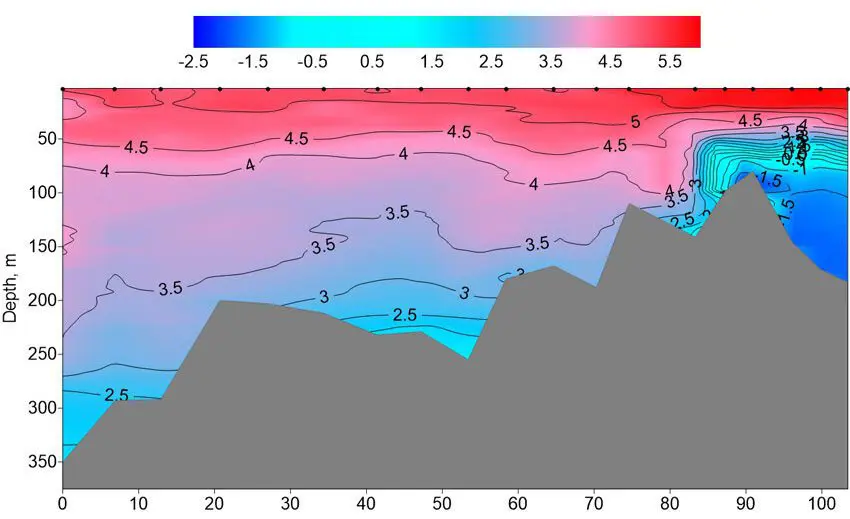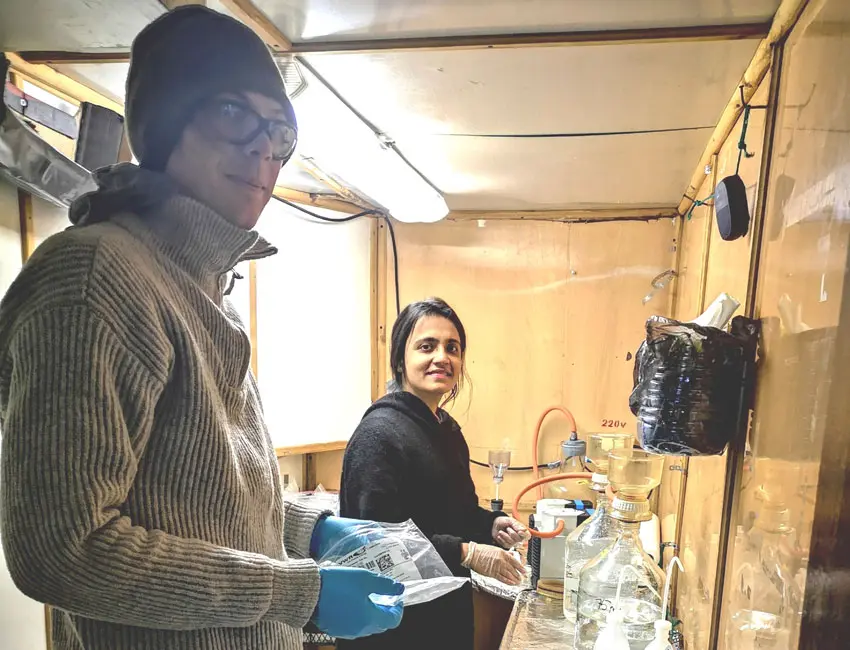We measure the temperature of Isfjorden

Top image: The sea temperature in Isfjorden on 14 and 15 November 2019 from the outermost mouth (left) to the bottom of Billefjorden (right). Graphics: Janne E. Søreide/UNIS.
We have been out again to take measurements in Isfjorden, this time with our good colleagues from the Murmansk Marine Biological Institute (MMBI).
17 December 2019
Text: Janne E. Søreide, Ragnheid Skogseth, Anna Vader and Frank Nilsen (UNIS); and Aleksander Derjabin, Tatjana Maximoskaja and Denis Moiseev (MMBI).
We have been out again to take measurements in Isfjorden, this time with our good colleagues from the Murmansk Marine Biological Institute (MMBI) and their research boat “Dalnie Zelentsy”, which is in Svalbard once or twice a year. MMBI and UNIS work closely together to maintain the time series on hydrography (ocean climate) and plankton from the inner part of the Billefjorden to the outermost of Isfjorden, something we have been doing together since 2015 and separately since the end of the 1990s.
Colder than normal
The air temperature in October has been colder than normal, as low as -14.5 degrees Celsius. We were therefore very excited to see how the water temperatures were in Isfjorden in mid-November. The last time we checked this was in early September and then there was hot water (> 4.5 °C) from the surface down to 50 m depth along the entire fjord. In November it was much colder; down to zero degrees in the upper water masses. This is colder than what we have measured over the last 10 years at this time of year, and shows that there has been a clear cooling since September.
Below 100 m, on the other hand, we see an increase in the temperature in the outer and middle Isfjorden (Sassen), which indicates the inflow of warmer water into Isfjorden since September. Billefjorden is an exception since it is a threshold fjord with 40 m as the shallowest threshold, and here, as expected, it was cold (-1 °C) water below 100 m. The threshold prevents warm Atlantic water from flowing into the fjord and thus contributes to that Billefjorden freezes every winter. When the temperature drops to -1.8 °C, seawater with the salinity we find in Billefjorden and Isfjorden will freeze to ice.

Will there be sea ice?
So how are the prospects for a good sea ice winter? The hot water that has been flowing in since September makes this difficult to calculate. When seawater gets cold, it gets heavier and sinks, and we expect a water mix from top to bottom in the time ahead. The large volume of hot water from 100 m down to the bottom will take a long time to cool down. In January this year, the water masses in Sassen were mixed with + 1.8 °C from the surface to the bottom.
Today’s cold surface water is relatively fresh (33.7 per milliliter) due to much runoff from land and melting of glaciers, while the warm waters of Atlantic origin are saltier (34.8-34.9 per milliliter) and thus heavier. If today’s surface water does not get heavier than the hot water underneath, it will act as a lid and prevent the mixing of the water column. In that case, we can get early sea ice formation and more sea ice than we have had in the last 10 years. But this depends on further cooling of the surface layer which in turn depends on low winter temperatures in the future. In Billefjorden, we can say with more certainty that it looks promising for early sea ice cover unless more hot water flows into Isfjorden and beyond the threshold into Billefjorden in the time ahead.
Related articles:
31.01.2017: Will there be ice on the Svalbard fjords this winter?
22.03.2019: Cold, but not cold enough!
